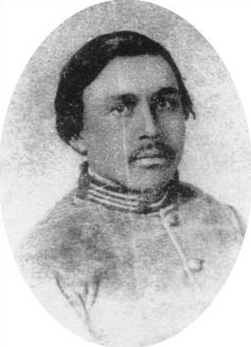Felix Huston Robertson facts for kids
Felix Huston Robertson (born March 9, 1839 – died April 20, 1928) was the only person born in Texas to become a general in the Confederate States Army during the American Civil War. He was known for some actions by his soldiers during the First Battle of Saltville. After this battle, some wounded African American Union soldiers were killed. This caused a lot of controversy.
Contents
Early Life and Education
Robertson was born in Washington-on-the-Brazos, Texas. His father, Jerome B. Robertson, also became a Confederate general. Felix went to Baylor University. Later, he attended the West Point military school in 1857. However, he left West Point before finishing his studies to join the Confederacy.
Military Career in the Civil War
Robertson started his military career as a second lieutenant in the Confederate Army's artillery unit. He went to Charleston, South Carolina, and took part in the Battle of Fort Sumter, where cannons were fired at the fort. After that, he served in Florida. He worked as a staff officer for Brigadier General Adley H. Gladden in Pensacola.
Rising Through the Ranks
In early 1862, Robertson became a captain. He led an artillery battery from Alabama. His unit fought in the Battle of Shiloh in April. He also served at the Battle of Stones River later that year.
Braxton Bragg promoted Robertson to the rank of major. He was given command of the reserve artillery battalion for the Army of Tennessee. He led this unit at the Battle of Chickamauga in September 1863.
Robertson was later promoted to lieutenant colonel. He was then put in charge of the Confederate horse artillery under Joseph Wheeler. He took part in the 1864 Atlanta Campaign. His actions during this campaign caught the attention of his senior commanders. On July 26, 1864, he was made a temporary brigadier general. He also became Wheeler's chief of staff. During a break from duty, he married Sarah Davis.
Controversy at Saltville
Later in 1864, Robertson was given command of a cavalry brigade and then a division. He was involved in a victory against Union troops at the First Battle of Saltville in Smyth County, Virginia, on October 2. Many of the Union soldiers in this battle were African American.
After the battle, some wounded African American Union soldiers were killed. This was a very serious event. When General Robert E. Lee heard about it, he was very concerned. He told General John C. Breckinridge that a general officer should not have been involved in such actions. Lee ordered Breckinridge to investigate and bring charges against Robertson. One of Robertson's officers, Champ Ferguson, was later executed after the war for his role in what was called the "Saltville Massacre."
End of War Service
Robertson was badly wounded in his elbow during the Battle of Buck Head Creek near Augusta, Georgia, in late November 1864. He survived, but he could not return to active duty in the field.
On February 22, 1865, the Confederate Senate did not approve Robertson's promotion to brigadier general. He was captured in Macon, Georgia, on April 20, 1865.
Life After the War
After the Civil War, Robertson went back to Texas. He settled in Waco. He studied law and passed his bar exam, becoming a successful lawyer. He and his father also invested in real estate and local railroads. After his first wife passed away, Robertson married again in 1892.
In 1902, Robertson tried to get into local politics. He ran for mayor of Waco in the Democratic primary elections. However, he lost to the current mayor, J. W. Riggins.
In 1911, Robertson became the leader of the local United Confederate Veterans group. In 1913, Texas Governor Oscar B. Colquitt appointed him as the Texas representative for the Battle of Gettysburg Commission. This national group celebrated the 50th anniversary of the battle in July 1913.
Felix Huston Robertson died in Waco, Texas, on April 20, 1928. He was buried in Oakwood Cemetery in Waco.



